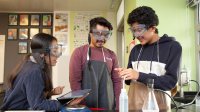How to Develop Students’ Science Media Literacy
Lessons on how science-related topics are presented in the media prepare students to make informed judgments about what they read.
Your content has been saved!
Go to My Saved Content.Science media literacy is a content-specific form of media literacy. It complements the science knowledge that forms the core of compulsory science education. The goal of science media literacy is to prepare students to understand and critically evaluate media reports of scientific issues. Students develop the skills needed to distinguish between evidence-based information, pseudoscience, misinformation, disinformation, and entertaining content.
Science media literacy incorporates science literacy and media literacy. Media is a leading source of scientific information for the public, including students, who frequently encounter and share news and information through various social media platforms and other digital communication tools. However, textbook science in formal educational settings is often different from the way science is represented in mass media.
Science media literacy engages students as active citizens with science-related issues and prepares them to make evaluative judgments as they weigh evidence to make informed decisions about scientific claims. It enhances students’ decision-making skills through critical analysis of content accuracy, implied values, and ethical considerations. Above all, science media literacy highlights science as a complex domain that intersects with technology, society, and the environment.
Interacting With Science in the Media
Science in the media is prevalent and can be a significant source of teaching material. Unlike the objective, factual nature of most science curricula, the media reports science as a complex human activity. Science in the media is a real-life context that offers students an opportunity to understand science as represented in the public sphere, not an area exclusive to scientists.
Mass media, such as news articles, social media platforms, and advertisements, serve as an informal avenue to increase students’ public awareness of science.
- Science articles and news may include scientific or technical terms but are mostly written for the nonscientist audience. They can be used to reinforce school science by promoting discussion and debate.
- Social media platforms often share opinionated news. They insufficiently report science issues, which may lead students, as citizens, to make misguided choices.
- Advertisements often use scientific terms to promote a product. Advertisements can be used to teach students how businesses use science as a marketing strategy. Students, as consumers, learn how to challenge the given information and make informed decisions.
Making It Relevant to Students
Students navigate complex media platforms with rapidly changing information shared by diverse sources that have varying levels of expertise and intentions. Even though students learn science content, they often lack the skills to meaningfully integrate their knowledge into everyday thinking. Science media literacy can be integrated in science curricula as early as elementary school and continued through high school.
Teachers may start with topics that the students already are familiar with and tailor the lessons based on the grade level. Some examples include nutrition (diet culture, supplements), sports (energy drinks), the environment (genetically modified organisms, climate change), allergies (homeopathic products, allergy testing kits), or any advertisement that uses science to promote a product (personal hygiene, detergents, skin care, makeup, toothpaste).
Without appropriate training, students would find it difficult to critically engage with media content. They might overestimate the certainty of scientific claims and accept them without questioning the source, the product, the study, or the credibility of the news outlet. Moreover, they might be misled by terms such as “evidence-based” or “scientifically proven” without a deep conceptual understanding of what they are reading.
Science media literacy supports a student-centered approach to science education by doing the following:
- Promoting students’ critical thinking skills as they analyze issues from multiple perspectives to evaluate potentially biased information. It also enhances the students’ argumentation and discussion skills.
- Preparing students to become clever consumers of information. Students will be able to understand and respond critically to science issues reported in the media.
- Developing a skeptical attitude toward media reports of science.
Helping Students Develop Critical Thinking Skills
Science educators can use science in media as an informal avenue to explore science beyond the textbook. Using media, whether articles, news, or advertisements, reinforces school science and provides a novel learning experience for students. Students can identify inaccurate or misleading science and discuss the problematic nature of biased reporting, which may be useful for correcting misconceptions.
I encourage science educators to include media science as instructional material that supports their students’ development of science media literacy. The science classroom offers the foundation for students to achieve practical science media literacy skills that require open-mindedness, critical thinking, and inquiry-based learning.
Through science media literacy, science educators teach students to accept ambiguity as they distinguish evidence-based science from opinionated views, correctly identify the nature of scientific information in media, and request further evidence when encountering claims that are not supported by evidence.
Advocacy Starts With Leaders and Teachers
Science media literacy reinforces our science curricula because responding to media representations of science requires not only knowledge of media but also substantive knowledge of science content. Students learn how to appreciate multimedia culture as well as how to become active media consumers and users.
This is a call for school leaders and science educators to advocate for science media literacy as a core goal of education. Science media literacy empowers students as current and future citizens and prepares them for lifelong learning beyond school. It gives students the ability to understand and evaluate the overwhelming content available at their fingertips.
